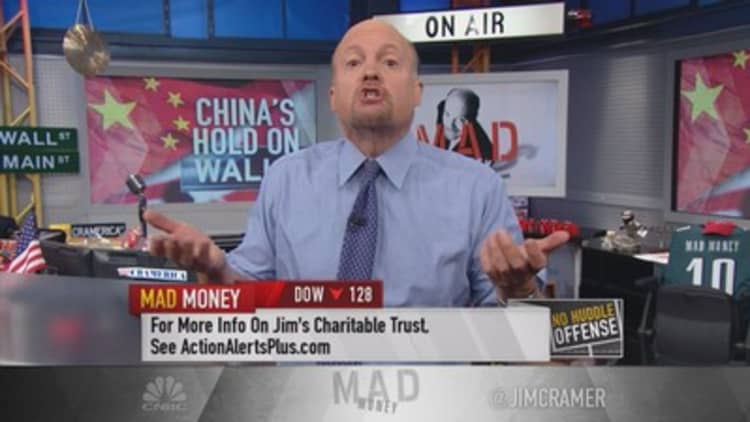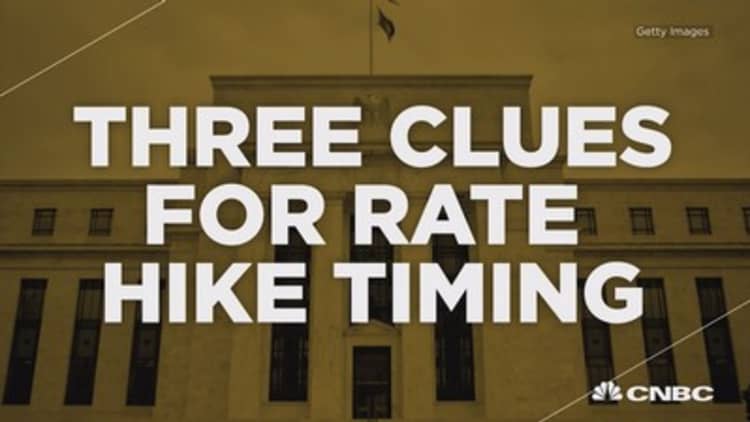


U.S. stocks have some powerful negatives tugging at them, not the least of which are the Shanghai "panda bear" market and a global commodities rout.
But there is also the Fed, and it meets Tuesday and Wednesday amid shaky markets. While the U.S. central bank is not expected to take any action or make any major new comments, some traders expect its statement to sound hawkish to a nervous market as the Fed moves toward its first rate hike in nine years. Positive tones on the U.S. economy from the Fed could be a positive for stocks, even though it could signal a rate hike ahead.
Stock futures were higher Tuesday, after selling in Shanghai slowed overnight. The Shanghai market was off 1.7 percent, erasing its worse Tuesday losses, following Monday's sharp decline. The dollar gained, but commodities, like oil and gold continued to sell off.
That nearly 8.5 percent downdraft in Monday set the stage for weakness that was compounded by further selling in commodities. The S&P 500 dipped 12 Monday to 2,067, after slipping to 2,064, its 200-day moving average. The worst performing sectors were energy and materials, both down more than 1 percent.

The S&P ended Monday down 2.8 percent from its July 20 high of 2,128, and 3 percent from its May 21 all-time high of 2,130. The number of new lows continued to grow with 57 on the S&P 500 on Monday, and 467 on the New York Stock Exchange. The NYSE new lows were at the highest level since Oct. 15, a day when the S&P 500 was trading sharply lower, according to Reuters. Out of the 3,211 issues on the NYSE, 2,275 or 71 percent declined.
Ari Wald, technical analyst at Oppenheimer Asset Management, has been watching these trends and he sees some red flags. Participation is one issue, where a select group of stocks are the leaders, and there are others, he said. "Internal breadth has become much more narrow. I think that would argue for a bull market correction," he said.
Wald said he's neutral on the market now and the correction could take the S&P down about 7 to 8 percent. There could be support at the 1,970 area.
If not the catalyst, China is at least creating a backdrop of uncertainty with markets watching to see if its stock market meltdown could bring on further economic weakness. Shanghai's Monday losses were the worst in eight years.
Read MoreChina would have to get a lot worse to stall Fed
UBS strategists, meanwhile also said stocks could be in for more downside. They said said the earnings news from energy and industrial companies may add to the uncertainty.
"We expect earnings announcements reactions from these two beleaguered groups will be very informative in light of the "Growth Scare" messaging from lower commodity prices coming at a time when the Fed is expected to reinforce its intention to raise rates in 2015. Higher volatility and yet another downside test of the S&P 500's compacted 2015 range (1,980-2,135) would appear to be in store," they wrote.
Janney Montgomery's chief market strategist, Mark Luschini, agrees the market could be entering a more corrective phase, and things like weak U.S. earnings and China's selloff are now concerns.
Read MorePostcards from China: What US investors can learn
"The market has shrugged off all these issues in the past. It's been remarkably resilient, and you always worry about saying this time is different ... you look at how the number of stocks hitting new 52-week lows is increasing. The number of stocks trading above their long-term trend liens is falling. You look at the advance-decline ratio. It's slipping, and if you look at the performance of the New York Stock Exchange composite versus the S&P 500, it's much weaker," he said.
Wald said he expects to see more weakness in some of the market laggards, and they could actually break down more than some of the leaders. He said the market is in a seasonal time when a correction is more likely. He said even though the market is struggling against falling commodities-related stocks, historically it has gained when commodities sell off.
Read MoreWhy Dennis Gartman changed his mind on US stocks
"This could be the start of [a correction] or we could rally back here and it could be a choppy few months. Between mid-July and early October is when you expect to see [a correction]," he said. Wald did a study that showed commodities selloffs are not historically negative for stocks. Since 1957, the S&P 500 has gained 12.6 percent in the 12 months when the equal-weighted commodities index is in an a downtrend, or under its 200-day moving average.
When commodities are in an uptrend, the S&P has gained just an average 4.6 percent.
Wald also found technology and consumer discretionary have been the key leaders over the next 52 weeks, with average gains of 6.7 percent and 4.1 percent, respectively.
Besides the start of the Fed meeting, there are several important data points Tuesday. S&P/Case-Shiller home prices are reported at 9 a.m. ET, and consumer confidence is at 10 a.m.
There are also dozens of earnings releases before the market open, including BP, DuPont, Ford, LVMH, Merck, Pfizer, UBS, UPS, JetBlue, AK Steel, Corning, Cummins Engine, DR Horton, Ingersoll-Rand, Marsh & McLennan, Paccar, Precision Castparts, Sirius XM Radio and Peabody Energy. After the bell reports are expected from Twitter, Gilead Sciences, Anadarko Petroleum, Yelp, U.S. Steel, Panera Bread and IAC/Interactive.
"I think the market has sort of run into the wall of full valuations. Certainly, there's mixed earnings news coming out of the iconic sort of generals in the marketplace. That puts investors on notice," said Luschini.
But for markets overall, the big news of the week comes Wednesday.
"The FOMC statement will be the pivot point. ... They definitely don't want to trigger an unnecessary slowdown. For the time being, the balance of weight goes to December rather than September because of China," said Boris Schlossberg, managing director of foreign exchange strategy at BK Asset Management.
Read MoreWhy US stocks may rebound in second half: Strategists
Goldman Sachs stock strategists, in a note Monday, said their recent client meetings indicate investors believe the economic uncertainty in China could lead to the Fed delaying its first rate hike until 2016. The central bank has said it would like to raise rates this year.
A number of economists, however, say they don't believe China will sway the Fed unless its stock market selloff tips off a bigger economic slowdown that spills into the world market.
"I think the dollar gets a boost if the Fed has a tone that says we think a rate hike is sooner rather than later," Schlossberg said. "If there's no oblique reference to China, maybe the market will see it as hawkish."
The dollar index was 0.7 percent lower and the euro was trading at $1.10. Treasury yields were down in a safety trade, and a whole range of commodities declined. , however, attempted to rally but futures continued to trade below $1,100 an ounce. West Texas Intermediate crude futures fell below $47 per barrel in late trading.


